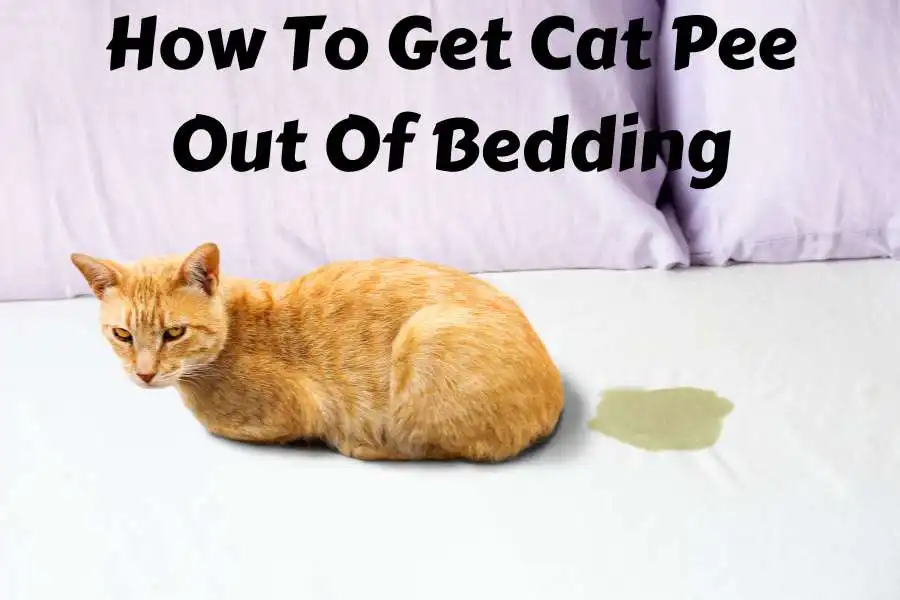Cats are undeniably cute and cuddly, but their urine smell isn’t, especially when it’s on your bedding. If your cat enjoys sleeping on your bed, you may have encountered instances of cat urination on your bedding blankets, and you appreciate how difficult dealing with cat urine on linen can be.
Cat urine can be one of the toughest stains to remove from your bedding, blankets, or duvets, giving off an insufferable smell when you need to rest after a long day of work. The proteins in cat urine bind to the bed cover and bed sheet fibers and become even harder to remove, especially if exposed to elevated temperatures.
Also, the uric acid in the urine is insoluble in water, rendering most ordinary cleaning methods inadequate.
However, with a proper understanding of how to get cat pee out of bedding using effective cleaning agents, techniques, and tools, you can remove cat urine from your bedding and get your linens smelling fresh again. We’ve got you covered!
Understanding Cat Urine

Before jumping into the cleaning process, it’s essential to understand the chemicals and organic compounds responsible for the pungent odor accompanying cat urine. They include:
- Uric acid
- Urea
- Urobilin/urochrome
- Creatinine
- Ammonia
- Bacteria
- Felinine or pheromones
- Sodium and other electrolytes
Main Precautions To Take
Precaution #1: Wear protective gloves.
Precaution #2: Read the care tag on your bedding and follow the washing instructions to avoid damaging the bedding. Also, test them on an inconspicuous area of your bedding (or blankets and duvets) before applying them.
Precaution #3: If you must use bleach, use oxygen-based bleach like Oxi-clean. Ammonia bleach, which may smell like cat waste to your cat, can attract the cat to soil the bedding again.
Precaution #4: Be careful while using chlorine bleach as it may damage the fabric, and combining chlorine-based bleaches with cat urine can produce toxic chlorine fumes.
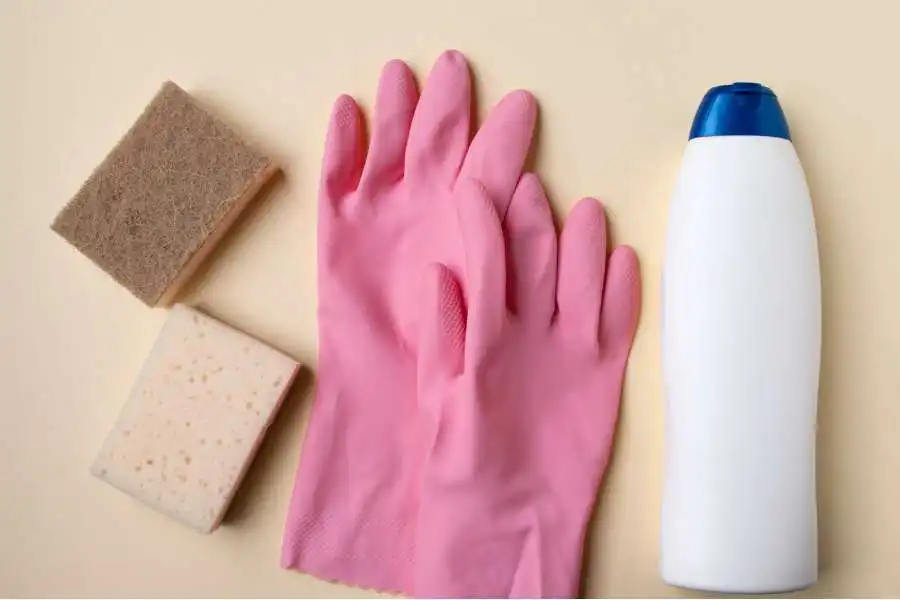
What You’ll Need
- Protective gloves
- Paper towels or clean towels
- Cleaning agents like enzymatic cleaner, oxygen-based bleach or white vinegar
- Cold water
- Baking soda, 3% hydrogen peroxide
- Mild dishwashing soap
- Spray bottle
- Washing machine (for machine-washable bedding)
Steps to Remove Cat Urine from Bedding
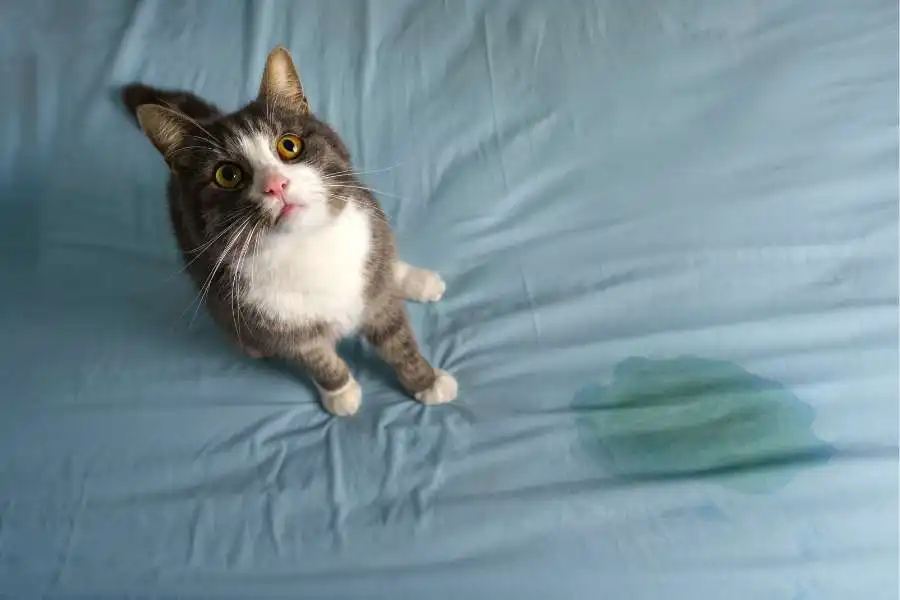
Removing cat urine from bedding is a multi-step process that requires patience and persistence. Here’s what you need to do:
Identifying The Affected Area
The first step in removing cat urine from bedding is identifying the affected area. If you are unsure where your cat has urinated, use a black light to locate the urine stains. Usually, the cat urine stain glows fluorescent white when illuminated with black light or ultraviolet rays.
Remember, identifying the extent of the urine stain is vital to removing the whole odor from the bedding and lowering the likelihood of your cat returning to pee on your bed sheets, duvet, bed cover, or blanket again.
Immediate Action To Remove Cat Pee

Wet urine stain: Once you’ve identified the affected area, use paper towels or a clean cloth to blot up as much urine as possible or until the paper towels are dry. Do this until the paper towels turn up dry.
However, this process is much easier if you use a wet vacuum. It is capable of sucking up a lot more of the liquid than you can blot.
Dry urine stain: If the stain has already dried on the bedding, the uric acid in the urine has crystallized and bonded rather strongly with your bedding, blankets, or duvets. Therefore, rinse it with cold water to loosen it from the fabric, and blot the wetness with paper towels.
Be careful not to rub the urine into the fabric, which will worsen the stain. Avoid rubbing the area or using heat, as this can set the stain and make it harder to remove.
After blotting, apply a pre-treatment solution like enzymatic cleaner to the affected area to break down the urine and make it easier to remove in the wash.
How To Get Cat Pee Out Of Bedding: Pre-Treatment Of Cat Pee Stains

Pre-treatment prevents the spread of the cat urine odor to the rest of the laundry load and helps achieve better results at the end of the cleaning process. Before other detailed cleaning methods, the pre-treatment stage removes as much cat urine as possible.
There are several pre-treatment solutions to remove cat pee stains from bedding, including store-bought products specifically designed for cat urine, like an enzyme-based cleaner, or homemade solutions like baking soda or white vinegar.
Apply an enzymatic cleaner and allow it to sit for a few minutes. If the stain persists, gently scrub it with a soft-bristled brush before rinsing the spot with clean and cold water.
For homemade pre-treatment of your bed sheets, duvet, bed cover, or blanket, follow the steps below:
Step #1: Mix white vinegar and water in a spray bottle and saturate the soiled spot with the cleaning solution. Allow the solution to sit for at least 10 minutes.
Step #2: Use a wet vacuum, paper towels, or an old towel to dry the spot as much as possible by dabbing the wet patch instead of rubbing it.
Step #3: Apply a layer of baking soda to the spot and spread it evenly above the wet area. Baking soda is effective at soaking up urine odors and moisture from your bedding. Rinse and repeat if necessary.
Step #4: Mix one teaspoon of mild dishwashing soap and a quarter cup of 3% hydrogen peroxide in a spray bottle and apply it on top of the baking soda.
Step #5: Allow the cleaning agent to sit for at least 15 minutes, and rinse the spot with cold, clean water.
Get Cat Urine Out Of Bedding: Washing Cat Pee Stained Bedding
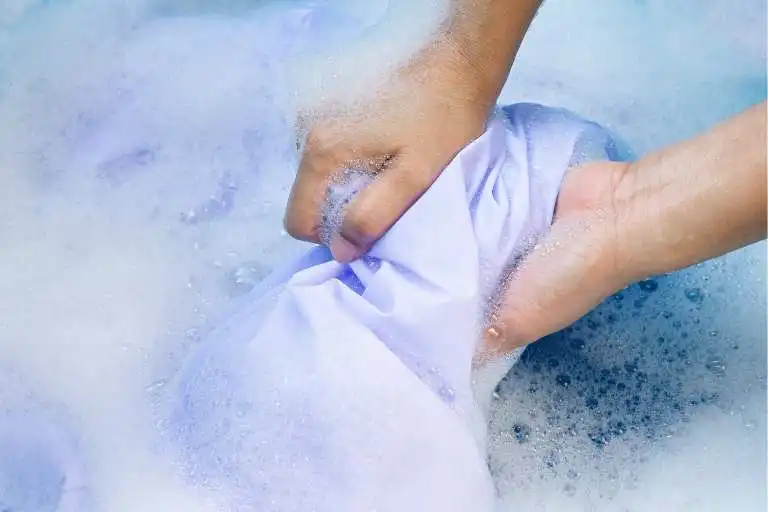
In this phase, you need more effective cleaning agents, like enzymatic cleaners specially formulated to break down the odor-causing organic compounds in cat urine that are otherwise insoluble in water.
Follow the user instructions for the cleaning agent you use and test it on an inconspicuous area of your bedding before applying it to it.
Hand Wash The Bed Sheets, Duvet, Bed Cover, Or Blanket
Step #1: Apply the cleaning agent to the soiled part of the bedding and allow it to sit for the recommended time.
Step #2: Scrub off the stubborn stain with a soft-bristled brush.
Step #3: Rinse the area with cold water to remove the cleaning agent and any lingering stains. Repeat these steps if necessary.
Learn How To Get Rid Of Dog Pee From Your Mattress
Using A Washing Machine To Clean Cat Urine From Your Bedding, Blankets, And Duvets
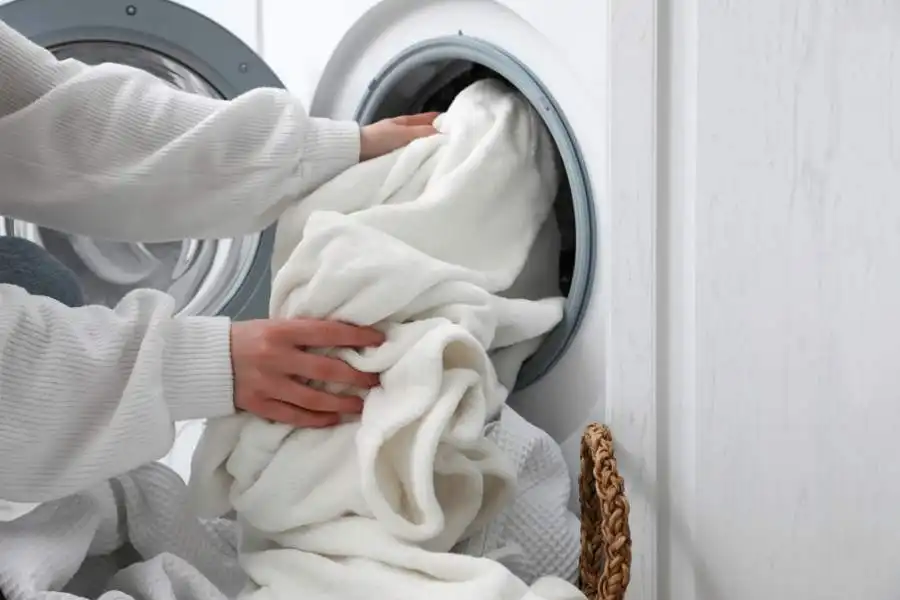
If the stain or odor lingers, you can clean the bedding in a washing machine and use an effective commercial product.
Step #1: Toss the bedding in a washing machine on cool or cold water, gentle cycle setting, and add a suitable cleaning agent or laundry detergent. You can also add a cup of white vinegar and baking soda to help neutralize the odor.
Step #2: After washing, inspect the bedding to ensure the stain and smell are gone before drying. Consider a second wash cycle if necessary.
You can also use dryer sheets or fabric softener to add a fresh scent to the bedding.
Drying Cat Pee-Stained Bedding, Blankets, And Duvets

Air drying is the best way to dry the bedding after washing – the fresh air and adequate sunlight can help remove any lingering smells.
The sun is also a natural disinfectant that can remove any remaining smells. However, avoid leaving the bedding in the sun for too long, as this can damage the fabric.
Do not dry your bedding with a dryer; the heat can permanently set any lingering odor in the fabric. Once the bedding is dry, please give it a sniff test to ensure there is no remaining odor.
Still Smell Cat Urine? How To Get Cat Pee Smell Out Of Bedding
If the cat pee smell persists, you can take several additional steps. They include:
Consider reapplying an enzymatic cleaner to the stain; as mentioned earlier, enzymatic cleaners are specifically designed to break down the acid and chemicals in cat urine. They can be effective in removing the smell.
Activated charcoal can absorb odors and be placed in a container near the bedding to help eliminate the smell.
Finally, drying the bed sheets, duvets, bed covers, or blankets in a well-ventilated area can also help remove any remaining odors.
Why Does Cat Pee Smell So Bad?
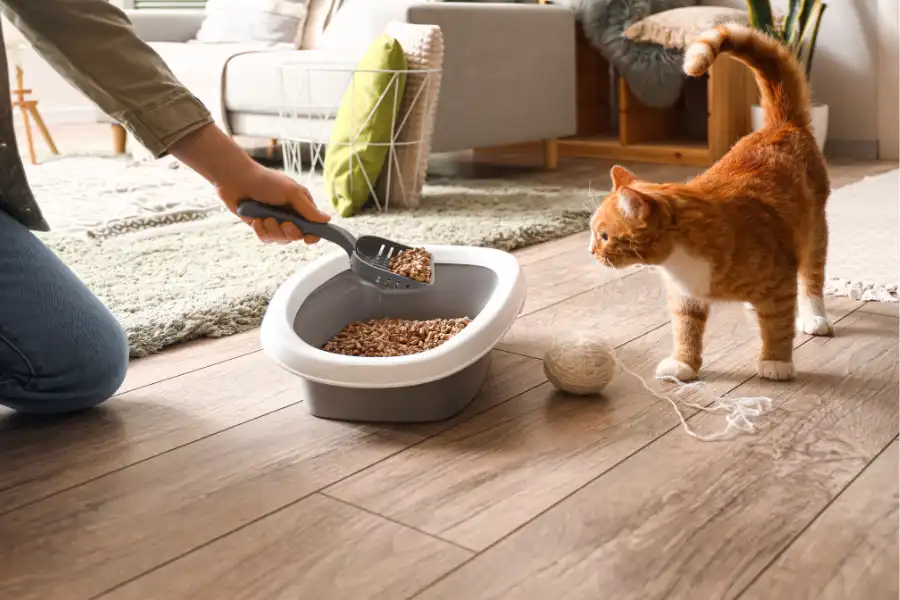
Although the compounds listed above are also present in human urine, their concentration is much higher in cat urine. This is because cats evolved as desert animals with a digestive system able to squeeze almost all the water from their food and make their waste more concentrated than that of other mammals.
Learn more about why cat urine smell so bad here.
Once the urine has stained the fabric, it releases a pungent smell while it decomposes gradually. Usually, this breakdown predominantly occurs in two stages, beginning with the breakdown of urea to produce an ammonia-like odor.
As further decomposition takes place, the urine begins to release felinine, a type of amino acid with sulfur, a known precursor of pheromones or mercaptans, and a major cause of the skunk-like or sulfur-like odor of cat urine.
Certainly, other factors play a significant role in influencing the odor of your cat’s urine, such as:
- Diet
- The sex of the cat (urine from male cats has a higher concentration of felinine, which makes their urine fouler).
- The cat’s kidney efficiency (which is often compromised in elderly cats)
- Amount of water intake
- General health of the cat: urine from cats with urinary tract infections smells like fish, while a strong sweet or fruit-like smell may indicate feline diabetes.
So, why does cat pee smell so bad? The unique smell enables your cat to communicate with other cats, attract a mate, mark its territory, and fend off other cats or predators.
And so, a cat may pee on your bed when feeling threatened or anxious – a topic that will discuss in this post.
Why Do Cats Pee On beds?

It can be confusing why your cat is peeing on your bed, especially when its litter box is kept clean, and you spend enough time playing together or bonding.
It helps to know that the cat is not peeing on your bed to spite you, and punishing or reprimanding the cat is not likely to help.
Several factors can lead your cat to pee on your bed and can be categorized mainly between medical and behavioral reasons.
1. Medical Reasons
A sick cat might find it hard to hold the urine for long or reach the litter box on time. There are illnesses that cause urinary tract inflammation and an urgent urge to pee.
When your cat has a UTI, it learns to associate the litter box with the pain it feels during urination. Instead, it soils your bedding, looking for a soft surface to relieve itself.
It is best to take your cat to a vet to rule out medical issues that lead to litter box aversion. They include:
- Urinary tract infection
- Arthritis or Joint Issues
- Bladder infection
- Kidney stones
- Diabetes
- Hyperthyroidism
When your cat is urinating inappropriately, look for signs of illness, such as:
- Cloudy urine or crystallized urine – The normal color of urine should range between pale yellow and light amber. Cloudiness is a sign of the presence of solid matter in the cat’s urine)
- Frequent urination.
- Urine comes out in bouts, or no urine comes out at all, when the cat squats to pee.
- Vocalization during urination.
- Excessive water drinking.
- Excessive licking of genitalia.
- Loss of appetite, etc.
2. Psychological Issues
Due to stress and separation anxiety, your cat urinating on your bed, which smells like you, is its way of coping with tense situations.
Cats are territorial animals and a common source of stress, including sharing turf with other cats. Your cat can also get stressed when sharing food, water, toys, sleeping area, or litter boxes with other cats.
When not properly managed, stress and anxiety can lead to idiopathic cystitis – a bladder inflammation, which may aggravate the cat pee problem.
3. Behavioral Issues
A drastic change in routine can alter your cat’s behavior, as cats are creatures of habit and cherish predictability. Below are the common issues that lead to behavioral change in your cat:
- Looking for a mating partner.
- A new person or pet has moved into your home, threatening or unsettling the cat.
- You move furniture around your home or make radical changes in the cat’s living environment. E.g., noise in the house from a nearby construction site might startle the cat from time to time. Other home appliances that can make your cat nervous include clothes dryers, furnaces, and washing machines.
- Litter box issues, i.e., a dirty litter box, the wrong choice of design or color of the litter box (based on your cat’s personality), placing the litter in a low-privacy area, and an inadequate number of litter boxes in a home with multiple cats, among others.
- Wrong choice of litter. Does your cat prefer clumping or non-clumping litter? Dusty or dust-free? Scented or non-scented litter? Some cats are repulsed by scented litter. Since cats are originally desert creatures, they tend to prefer sand-like litter with refined grains.
- Depth of litter. Cats do not like shallow litter, as it makes it hard to bury their waste. Cats are inherently programmed to bury their waste to hide from their predators. Failure to cover its waste correctly is a survival concern that can stress a cat.
You can read more about the behavioral issues relating to inappropriate urination in cats here.
Preventing Cat Urine Stains And Odors

Preventing cat urine stains and odors from occurring in the first place is much easier than dealing with them after the fact. Luckily, you can do plenty of things to prevent your cat from relieving itself on your bedding, including managing the cat’s stress, optimizing its litter box experience, and minimizing access to your bed.
To learn more about why cats urinate on your bed and how to negate the problem in the future, read How To Stop Cats From Peeing On Your Bed.
Conclusion: How To Wash Cat Pee Out Of Bedding And Blankets
In conclusion, removing cat pee from bedding may seem daunting, but it is possible. By following the steps outlined in this guide, you can effectively remove cat urine stains and odors from your bed sheets, duvets, bed covers, or blankets, leaving it smelling fresh and clean.
Remember to act quickly, use pre-treatment solutions, and follow the washing and drying instructions carefully. With a little effort and patience, your bedding and blankets will return to their former glory soon!
That said, it’s essential to prevent cat urine stains and odors from happening in the first place. By providing your cat with a clean litter box, regularly cleaning it, and managing its stress and anxiety, you can reduce the likelihood of accidents happening.
Quick Roundup:
- Blot the cat pee as soon as possible
- Use pre-treatment solutions before washing
- Wash bedding in hot water with vinegar and baking soda
- Avoid high heat when drying
- Use enzymatic cleaners, especially when home supplies are unable to do the job
- To prevent cat urine stains and odors, provide your cat with a clean litter box, regularly clean it, and keep it away from their food and water bowls.
- Persistence and patience are key when dealing with cat urine stains and odors.
FAQs
Q. How can I tell if my bedding has been affected by cat pee?
A. The most obvious signs of cat pee stains on bedding are discoloration and a strong, unpleasant odor. If you notice any wet or damp spots on your bedding, especially if they have a yellow tint or a strong smell, it’s likely that your cat has peed on it.
Q. Is it safe to use hydrogen peroxide to remove cat pee stains?
A. Yes, hydrogen peroxide is safe to use to remove cat pee stains from bedding. However, it’s important to dilute the peroxide with water before use and to avoid using it on colored fabrics, as it can cause discoloration.
Q. What is the best way to pre-treat cat urine stains on bedding?
A. A mixture of white vinegar and baking soda can be an effective pre-treatment solution. Simply apply the mixture to the stain and let it sit for at least 30 minutes before washing.
Q. Can I use regular detergent to wash cat pee-stained bedding?
A. Regular detergent may not be effective in removing cat pee stains and odors. Instead, use a detergent specifically designed for removing pet stains or one that contains enzymes to break down the chemicals in cat urine.
Q. Can I use bleach to remove cat pee stains from bedding?
A. No, bleach is not recommended for removing cat pee stains from bedding. Bleach can react with the ammonia in cat urine and create harmful fumes. Additionally, bleach can cause discoloration and damage to the fabric.
Q. How many times do I need to wash the bedding to get rid of the cat urine odor?
A. This can vary depending on the severity of the stain and odor. It may take multiple wash cycles and pre-treatments to eliminate the odor completely.
Q. What can I do to prevent my cat from peeing on my bedding?
A. Provide your cat with a clean litter box and regularly clean it. Keep the litter box away from your cat’s food and water bowls, and provide enough litter boxes if you have multiple cats. Consider taking your cat to the vet if they are consistently peeing outside their litter box.

